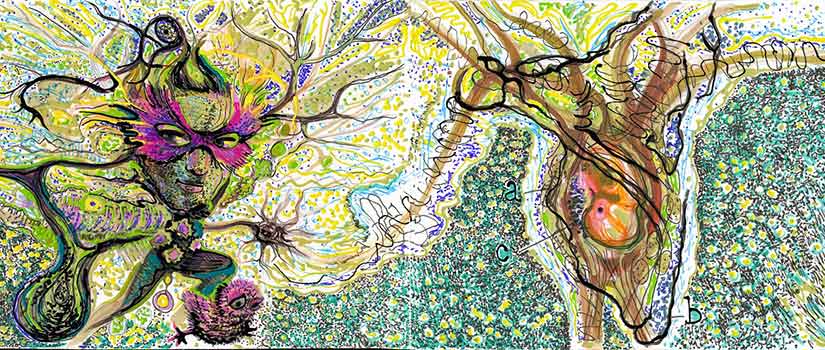SVAD professor connects art, science, history with Fulbright project
Sometimes you have to completely immerse yourself in a subject to see things from a new angle and pose questions others haven’t.
Just ask School of Visual Art and Design professor Dawn Hunter, who visited Spain on a mission to unravel mysteries about the father of neuroscience Santiago Ramón y Cajal. Hunter, a fine artist and medical illustrator, received the prestigious Fulbright Espana Senior Research Fellowship for her project that examines and represents Cajal’s life.
A Spanish scientist and pioneer of modern neuroscience, he was the first person to demonstrate that the nervous system is made up of individual neurons independent of one another but linked together at points of functional contact called synapses.
The Fulbright award supported Hunter’s series of drawings and paintings titled “Aesthetic Instincts: the Intersection of Art and Science in the life of Santiago Ramón y Cajal.” Her new body of artwork is an immersive, comprehensive biographical project that offered Hunter the opportunity to delve into Cajal’s history as a scientist and an artist.
“Cajal was always looking at things from the artist’s perspective,” says Hunter. “That is a key to understanding his work.”
Several years ago, after working with School of Medicine Professor Emeritus Jim Augustine on a text book, Hunter embarked on a project creating paintings that focused on themes from Cajal’s life. She then began immersing herself in understanding the Spanish scientist’s drawings and worked to recreate them. This included several trips to the National Institutes of Health in Maryland to see Cajal’s works there, which sparked her interest in going to Spain.
“There are things I only see and understand about him and his work through the process of drawing his scientific drawings,” Hunter said in her Fulbright application. “What I have learned is when he is trying to demonstrate how something truly exists within ‘life’ he draws a precise, continuous line of ink while viewing his subject through the microscope.”
While in Spain, Hunter continued developing her creative project by researching the extensive archives of the Cajal Legacy at the Instituto Cajal in Madrid. The Cajal Legacy contains microscopes, manuscripts and medals, as well as Cajal’s scientific drawings and photographs.
Juan De Carlos, curator of the Cajal Legacy, invited Hunter to apply for a Fulbright at the Instituto Cajal after meeting her and seeing her speak at a professional meeting hosted by the National Institute of Health. In 2015, Hunter delivered a presentation at the first international symposium honoring Cajal at the invitation of Jeff Diamond, National Institute of Neurological Disorders and Stroke senior investigator. Hunter also participated in the second international conference in 2017 at the Instituto Cajal in Madrid.
“It was an honor to receive such a tremendous life-changing opportunity,” says Hunter of the Fulbright Fellowship. “I am immensely thankful to everyone at the university, the NIH and the Instituto Cajal who have helped me in the development and realization of this project. I am particularly grateful the Dr. Jim Augustine for believing in the vision of my idea and encouraging me to invest in this creative endeavor. Cajal was such a fascinating and inspiring individual. I greatly appreciate the chance to deepen my understanding of him and his work through the amazing sojourn in Spain.”
